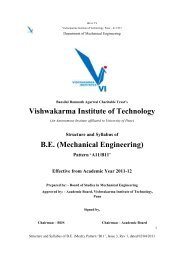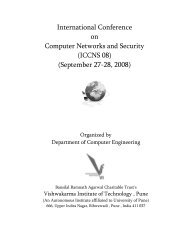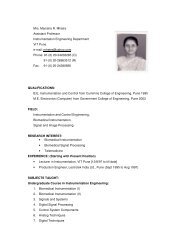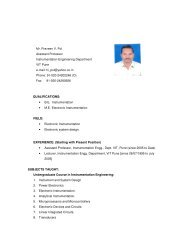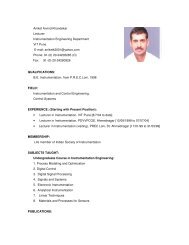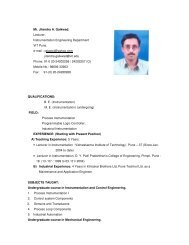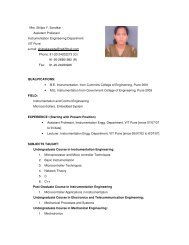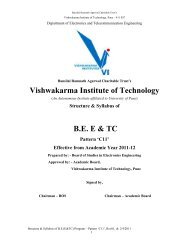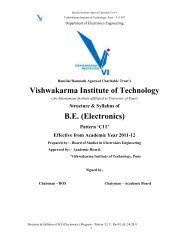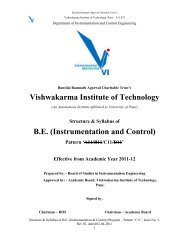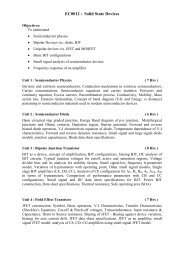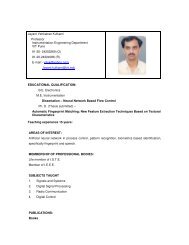Vishwakarma Institute of Technology Master of Computer ...
Vishwakarma Institute of Technology Master of Computer ...
Vishwakarma Institute of Technology Master of Computer ...
Create successful ePaper yourself
Turn your PDF publications into a flip-book with our unique Google optimized e-Paper software.
BRACT’S<br />
<strong>Vishwakarma</strong> <strong>Institute</strong> <strong>of</strong> <strong>Technology</strong>, Pune – 411 037<br />
Department <strong>of</strong> <strong>Computer</strong> Engineering<br />
CS72112:: GEOGRAPHICAL INFORMATION SYSTEM<br />
Structure & Syllabus <strong>of</strong> MCA Pattern C11, issue 03, Rev 01 Dt 2/4/2011<br />
34<br />
FF No. : 654<br />
Credits: 03 Teaching Scheme: - Theory 3 Hrs/Week<br />
Prerequisites: Nil<br />
Objectives:<br />
• To increase student awareness <strong>of</strong> GIS technology and provide opportunities to<br />
process, analyze and visualize spatial data and information.<br />
• To understand the complexities <strong>of</strong> data manipulation, analysis, and mapping at<br />
different scales <strong>of</strong> space, time, and complexity.<br />
• To study applications <strong>of</strong> GIS and Remote Sensing.<br />
Unit I (9+2 Hrs)<br />
GIS and Maps<br />
A. Fundamentals <strong>of</strong> GIS: Roots <strong>of</strong> GIS, Overview <strong>of</strong> Information System, Four Ms, GIS<br />
Definition and Terminology, GIS Queries, GIS Architecture, Models <strong>of</strong> GIS,<br />
Framework for GIS, GIS Categories, Levels/Scales <strong>of</strong> Measurement. Map Language:<br />
Map as a Model, Classification <strong>of</strong> Maps, Spatial Referencing System, Map Projections,<br />
Commonly Used Map Projections, Grid Systems, <strong>Computer</strong> in Map Production, Digital<br />
Database in a GIS, Linkage <strong>of</strong> GIS to Remote Sensing<br />
B. Selection <strong>of</strong> a GIS Application in Various Domains such as Weather Forecasting,<br />
Urban Planning, Agriculture, Defense, Network Applications.<br />
Unit II (9+2 Hrs)<br />
Remote Sensing Fundamentals<br />
A. Remote Sensing - Basic Principles: Electromagnetic Remote Sensing, Energy Sources,<br />
Energy Interactions with Earth’s Surface Materials, Microwave Remote Sensing: Radar<br />
Principle, Factors affecting Microwave Measurements, Radar Wavebands, SLAR<br />
Systems, Interpreting SAR Images, Geometrical Characteristics. Remote Sensing<br />
Platform and Sensors: Satellite System Parameters, Sensor Parameters, Imaging Sensor<br />
Systems, Earth Resources Satellites, Meteorological Satellites.<br />
B. Study <strong>of</strong> Satellites such as IRS, OCEANSAT-1, IKONOS etc.




